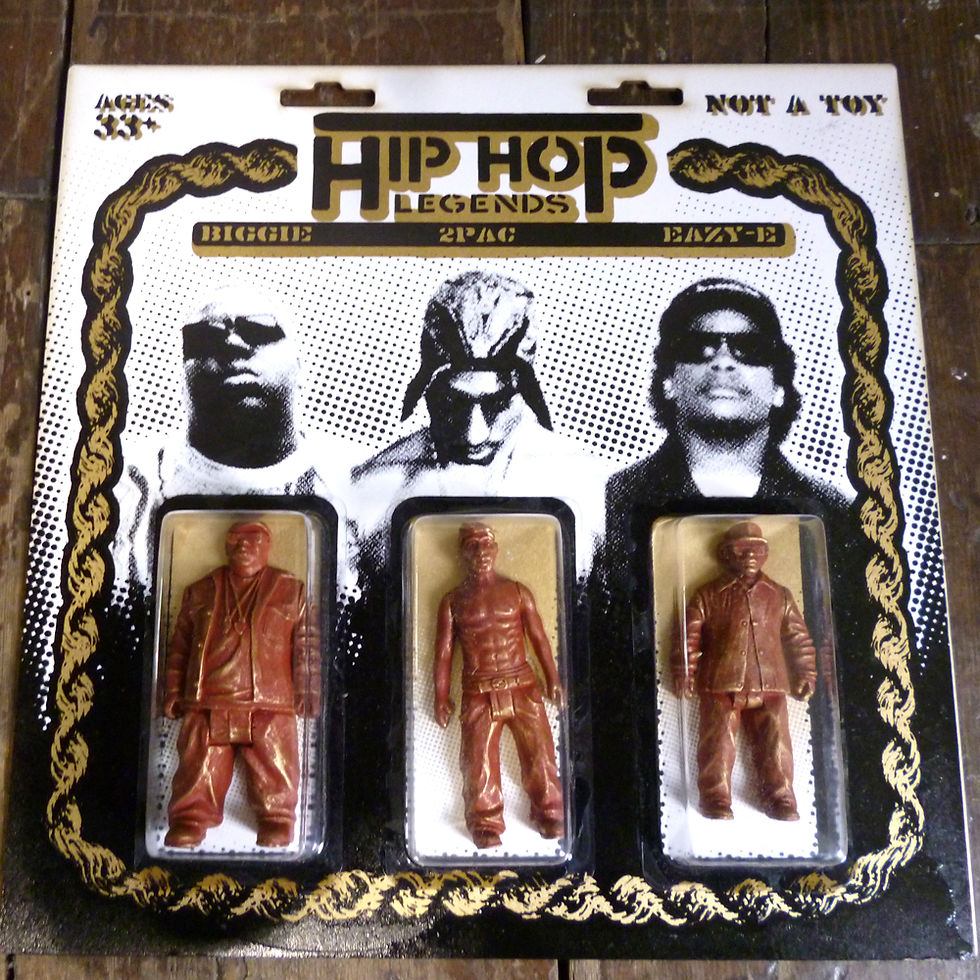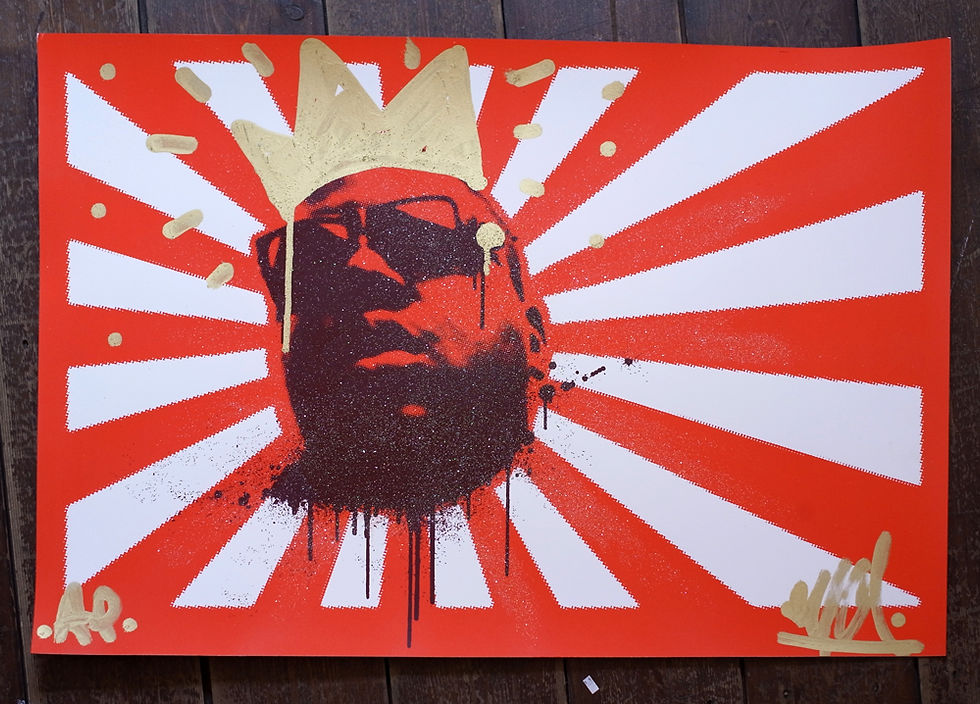Ryan Callanan
aka RYCA

BIOGRAPHY
Chosen as a British Jubilee Artist alongside Peter Blake, Ryan studied 3D Design and Modelmaking at Barking College, in Dagenham, London. In the early days, the artist started to experiment with street art and, soon after, he produced his first screenprint which sold out within weeks. He then became known as RYCA.
With a background in printing and pub sign-making, Ryan’s artworks employ a quirky and clever use of imagery drawn from popular culture. ‘It is important to me that my work is recognisable and accessible, that is why I like to experiment with symbols that I grew up with by appropriating them and giving them a humorous twist’.
Callanan's emblematic series of three-dimensional smiley faces, synonymous with the Acid House rave culture of the 1980s, quickly made him a name amongst collectors, who appreciated the artist’s original take on the famous symbol by using a new mix of gold-inlay and black-painted glass techniques and preserving an artisan approach to producing work.
Ryan employs his craftsmanship as a three-dimensional sign writer and model maker in order to create awe-inspiring limited-edition typography and sculptures. Many of his signs, made with glass, resin, gold and paint, explore the use of colloquial words, song lyrics and popular quotes. His collection of expletive-insertions, in which an expletive is inserted into a word, has become a symbol of Ryan’s playful diving into British popular culture; his experimentation with lyrics have resulted in highly collectable editions amongst musicians, music producers and writers.
Ryan's interest in working with different materials and methods keep his work fresh and in a constant state of change. ‘I’m interested in studying, discovering and experimenting with various processes and technological advances’, Ryan explains. Fellow artist Ben Eine has recently called Ryan a ‘chemist-like artist’.
Ryan would like to 'really establish the aesthetic of old fashion signage as an art form’.
Ryan Callanan has collaborated with acclaimed artists such as DJ Fatboy Slim, Sick Boy, Ben Eine, David Walker and Stik, amongst others.
We have been working with Ryan since 2010 when he first showed a solo body of work at ink_d Gallery, Brighton, where Dan was working as a curator.
Whistleblower Gallery continues to exhibit Ryan Callanan's body of work and is currently curating a solo show with new works by the artist.
EXHIBITIONS
2022
BLOOM, Whistleblower Gallery, April, Brighton, UK
2018
T.O.Y, Totems Of Youth, Whistleblower Gallery, April, Brighton, UK
Solid State, Solo show, Whistleblower Gallery, May, Brighton, UK
Futuretro, Group Show, Clutter Gallery, NY, USA
White + Black, Group show, Whistleblower Gallery, March/April, Brighton, UK
2017
Here we go!, Group show, Whistleblower Gallery, Brighton, UK
The POPTORIAN, Solo show - Lambert Gallery, London, UK
Inaction Figure, Group show, Clutter Gallery, NY, USA
Ddcc release with DKE Toys
Nycc with Toy Tokyo and Dke Toys
2016
The London Original Print Fair, TAG Fine Arts, Royal Academy, London, UK
AAF HK, TAG Fine Arts, Hong Kong, China
Metropolitan Pavilion, TAG Fine Arts, New York, USA
2015
Vernissage, 2 THREE GALLERY, Paris, France
AAF Battersea Autumn, TAG Fine Arts, Battersea Evolution, London, UK
Moniker Art Fair, The Old Truman Brewery, Shoreditch London, UK
Multiplied Contemporary Editions Fair, TAG Fine Arts, Christie’s, London, UK
Rough With The Smooth, Copro Gallery, Santa Monica, USA
2014
Perspectives, Robert Fontaine Gallery, Miami, USA
AAF Singapore, TAG Fine Arts, F1 Pit Building, Singapore
8 Forever, ink_d gallery, Brighton and Lawrence Alkin Gallery, London
Moniker Art Fair, TAG Fine Arts The Old Truman Brewery, Shoreditch, London, UK
Art14, TAG Fine Arts, Kensington, London, UK
London Art Fair, TAG Fine Arts, Islington, London, UK
2013
RYCA: Refresh, Robert Fontaine Gallery, Miami, USA
Moniker Art Fair, The Old Truman Brewery, Shoreditch, London, UK
Word Up, ink_d Gallery, Brighton, UK
2012
Highs and Lows, West Bank Gallery, London, UK
2011
The Symbols Won’t Save Us, ink_d gallery, Brighton, UK
AVAILABLE WORK
We sometimes have other available works by Ryan Callanan, or can accept commissions. Please get in touch if you want to know more.
SOLD WORK
INTERVIEW
A conversation with Ryan Callanan
by Dan Hipkin
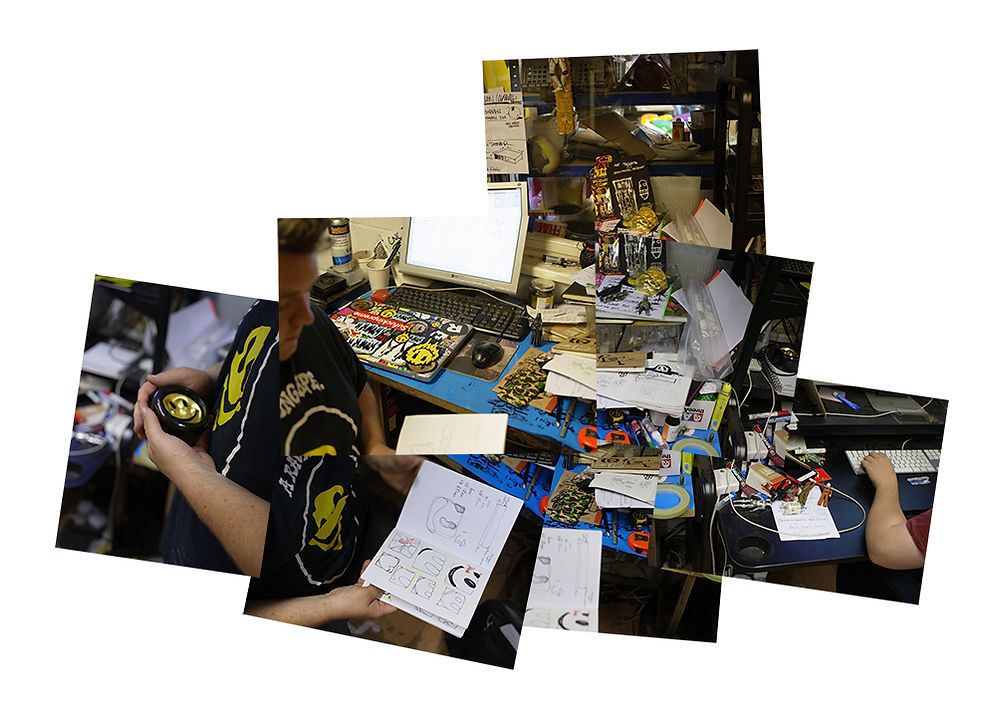
Where did you study and what was your background before you started in signage?
I studied Modelmaking at BTEC level at Barking College in Dagenham, where I lived. Afterwards I was supposed to do an HND qualification in Modelmaking, but the course had changed to 3D Design which meant we had to do a bit more art-based stuff, and less technical drawing. I felt my first school was quite well equipped but the college I went to was really behind in terms of technology. It was completely pointless. It took them two years to get up to date and turn the draughtsman suite into a CAD suite by which time we were way behind!
Was it useful acquiring those draughtsman skills?
Oh, yeah, definitely. I always liked technical drawing and asymmetric drawing and still kind of very much draw like that. I’ve never drawn anything that technical, really, my style is loose. The computer programmes I use now are not CAD but they are quite accurate… those skills I acquired in college did cross over but I appreciate having the delete button rather than an eraser. Having gone from physically cutting and pasting to doing it on a computer… well, I just find it bizarre to think we used to do the work manually.
Do you think that there is something that you made in those early days that you can see as a progression into what you are doing now?
Well, the only technical things I did in college were the figurines, and that is something I have been using in my work. I also did stuff like props, guns, you know, things like that. But when the brief was open enough for us to change the subject, I would do work related to films or TV, things I was really interested in… so my interest in popular culture, films and music has always been there. My GCSE final piece of art was a painting in impressionist style of Darth Vader talking to Boba Fett with Lando in the background.
There’s a connection or a progression, if you will, with your current work…
Oh, there’s definitely a connection. I don’t know if progression though… I’m still doing stuff like that now!

There’s been much talk about your early days when you started painting and working on the street… When was your first incursion in the street art scene?
My first experience was seeing a lot of street art around Soho, you know, lots of stencil work. Back then I thought it was all Banksy! I remember finding out there were loads of other people doing stencils. The first work that made me sit back and take notice was Eelus’ stencil on Starwars. Seeing that was absolutely amazing. The Banksy style was interesting, on point with social commentary and very, very witty; but realising you could mess about with movies and create something based on them was the key. I always had ideas about doing work related to Starwars so Eelus’ work really opened up the gates for me.
At the time I was working at a sign company, making pub signs, using silkscreens, mad inks and materials that have to go in those types of signs, you know, to make them robust and hardwearing. I remember buying my first print, which I really liked, but by the time I got home the print didn’t really look like the paper it was printed on was of very good quality. It looked flimsy. I then decided to experiment working with different types of paper myself and to mess around with my own silkscreens, and I ended up releasing a print of my own about six months later. So that’s how I first put my own work out there.
That was the ‘Ona Islam’?
Yeah, that was ‘Ona Islam’. That has become ten years old this year. That was the first piece I ever sold.
'I used to think all stencil work was by Banksy!'.

When you worked making pub signs, what type of work did you do? Could you tell me more about that?
I got hired (in 2003) because I could do sculpting. I started to work for an old fashion brand, a chain of pubs called Nicholson’s. They were redoing all of their signs; the subjects we were working on were side-profile portraits, coats of arms of whatever random thing the pub was called… mostly lions, red lions, white lions, load of coats of arms, Cambridge arms… I was doing the moulds, the bass reliefs, all that stuff. I learned to do inverted reliefs, metallic leaves, painted and open sections of glass to give the illusion of self- illumination... I worked making pub signs for a few years and during that time I also released four prints. Back then there was a trend in street-art to work on prints.
By the end of 2007 I was messing about with glass techniques and decided to make a micro sign using scraps that were laying around. I made my first couple of pieces that were movie quotes. The first one was ‘Beware of the Moon’, from An American Wolf in London and ‘Ape Shall Never Kill Ape’ from Planet of the Apes. I sold those, and then I did a few other pieces that I showed in galleries although that took over three years to accomplish.
Is that when you started to play with icons and the reinterpretation or transformation of quotes and images?
Yeah, oh, definitely. For me it was a natural process where I was taking something from the pop culture and reinterpreting in a different way. I would take a quote from a movie or a song, and executed it as a mini Victorian pub sign. I liked the idea of changing contexts. Sometimes I’d think of brilliant quotes but not all of them work our successfully. I guess the sentiment has to be strong enough.
Many of your pieces have a humorous side. How important is humour in the work you do?
I used to think all the time, ‘is that funny?' I really like humour but I’ve always tried to make stuff that doesn’t have the apparent comedy in it. When I was working on that first print, ‘Ona Islam’, I remember putting a drip on Mona Lisa’s eye which could be interpreted as a tear or as a drip of paint. That could be humour but at the same time it could be quite dark. I like leaving some pieces open to interpretation. It is really only now, ten years down the line, that I’m abandoning the comedy part and relying only on the craftsmanship. Jokes can get old but good craftsmanship doesn’t ever get old.
'It was a natural process: I took something from the pop culture and reinterpreted it in a different way.'

We’ve just walked through your studio and have seen a couple of your abstract smileys. That icon seems to be a strong part of your portfolio. How did you arrive at using smileys like that?
The smiley comes from music. I’m a toy collector but before that I was a record collector. I collected mainly Dance music, mostly British, and then Drum & Bass. I wanted to know how Drum & Bass started so I read a lot about it, I traced the roots to Garage and House, and the British scene of Acid House. Acid House is so much slower than what I was used to listening but you could see the lineage, the connections. It was so clear to me. But not many people give a shit about that, they don’t care where something comes from. I’m always interested in the roots, where styles come from, etc.
The smiley is so iconic. It represents a sinister smile. It’s takes you back to a time where people were taking drugs, dancing for just the love of dance, not hurting anybody, I mean some people died during that time but the casualties from that whole movement were nothing in comparison to today’s casualties on an average binge drinking weekend. The media spun that into this massive thing and they shut it down, the changed the law about people just coming together to dance... That was nuts.
In Britain this symbol has a complete different meaning than it does in the States. This happy symbol wasn’t so happy for everyone. There were victims and people suffered. People are still suffering the consequences of having taken acid. The smiley being black and yellow, you know, it’s like nature’s warning, like a wasp. It’s telling you you shouldn’t get involved, but it’s smiling at you at the same time. A lot of people look at the smiley in a nostalgic way. The smiley you mentioned only exists in negative, it’s untouchable, it’s in its glass box; you can’t touch the past, you can’t edit the past.
This was the first time when I realised that the Victorian signage style worked very well with imagery. Perhaps even better than with text. And it was also the first time that I saw this iconic image working in a different dimension. We live in a world where you have emojis everywhere and the use of them is growing so fast too. You can have a conversation online using emojis which you couldn’t have in words. This iconic image keeps on evolving. I like that.
Music has always been important for you…
Yeah, yeah, as I said, I was a music collector. I bought hip-hop first but then I discovered Drum & Bass and that completely changed my view. I realised that what Drum & Bass was doing was picking up the really best bits, the hooks, and then making them ultra catchy. Afterwards, you could afford to lose the rest of it, all you needed is the essence. Dance music does that as well. It was sampling, really. So I thought that’s what I wanted to do with my work. I find movies very interesting too but it’s music that has this way of connecting with people in intense ways.
You constantly use different methods and materials. Has that become an important part of the way you work?
Definitely, I’m always interested in technology and the latest innovations. 3D printing is happening, it’s growing fast, I use a CNC (computer-controlled cutting machine), I have a laser cutter… I like using all those things to make one other thing. The smiley, for example, will have a laser-cut edge and a CNC frame, and then a silkscreen glass on top; I’ll have five or six different processes. I like working on a piece that as all that complexity. For me it’s about exploring ways of making things quicker, easier and better. So I’m always reaching out to people in other industries that can teach me techniques and introduce me to materials that they can use better than me. I like experimenting too and I really enjoy re-appropriating a material that hasn’t been used in a specific way before.
I used to make smileys made of fibreglass and now I’m making them with blown Perspex. I'm using completely different techniques; you don’t suck the air out with Perspex, you blow air into plastic and then into a mould. The last smileys have come out better than ever because I have lost the uncontrollable shrinkage part of working with resin. It’s annoying not knowing how those pieces will come out. With resin there’s always a 3 to 5 percent shrinkage which you always lose, Now I know exactly how the work is going to be.
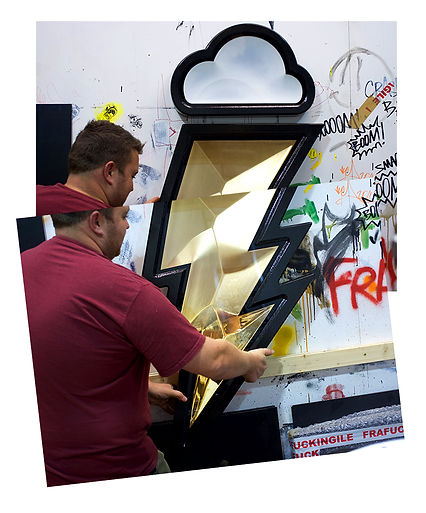
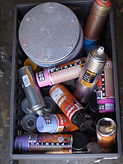
It must be exciting when you learn a new technology that allows you to have more control over the final product…
Yeah, absolutely! I’m always interested in trying out new things; one of the most exciting things in technology is that you can create something and then have it printed afterwards. I’m still not blown away by 3D printing but it’s got potential. Still, I like creating by hand. There’s something warm about it, and I don’t want to break away from it.
We have talked about music and films being a source of inspiration. What other sources of inspiration do you have, politics, the order of the world? Does that stuff come into it at all?
Well, this is the thing. Banksy did political commentary really well but adding the comedic element to it: He’s giving you a laugh, but the message is quite poignant, that’s why his work has held. I have done stencils or stencily-looking things with a message in them, but it kind of felt like I was regurgitating messages that other people had already done and were much better at it.
I’m now using the figurine format to make social, political, comedic pieces; G.I Joe is an example of that. I looked at Guantanamo Bay detainees and turned them into what looked like G.I Joe figures. Some of those guys were kept in Guantanamo Bay for over ten years and then they told them ‘we were wrong’, and released them after years of torture, the whole thing is just insane.
You have collaborated with a number of artists over the years. Do any of these experiences stand out? Is it a natural feeling to collaborate with others?
I would like to collaborate a bit more. Some collabs have been natural. I did a smilie with Eine where I gave him the parts of one of my pieces and he painted his name all over them. It was one of the first prints I remember seeing smiley faces on. So, yeah, that was pretty cool, seeing him paint on one of my things.
Sometimes the collaboration will mean I’ll be executing somebody's else’s work in a way they’ve never seen before. I produced a piece with INSA; he had a lot more to say about the work than some of the other people I have worked with. I had been experimenting with concave hearts; he turned them upside down which made them loo like asses with tights, and that really worked. That was in 2008 or 2009, I think.
What are you currently working on?
I’m currently working on some pieces for a solo show,. I’m using this as a departure from a comedic style, and making some originals which is completely alien to me. I usually work in editions just because of the way my studio is set up. The process I use doesn’t really suit one-offs. But I’m taking something that I have been doing for a while, abstract acid faces, and then reprocessing them in different ways. I have literally turned my work inside out. Having heavily relied on framed glass and concave surfaces, I’m now working with convex surfaces and no frames; there’s no big thick black lines to cover stuff, now it’s all in the open and it sits in a Perspex box.
It’s a modern presentation of a piece of work but I like to think it's very Victorian too. I like to look at these pieces in the same way medical items or taxidermy were presented in Victorian times. You could have a dissected frog with its guts sprawling out but the frog was still leaping. Now my piece is not made out of blood and guts but… somebody described it as ‘high gloss marshmallow’. I think it’s a good description.
It feels like you are deconstructing your work.
Absolutely. I’m now interested in taking hand-drawn processing through computer methods. I also want to draw more. Up until now, the majority of the stuff I've been doing is disciplined; it looks like it’s just been drawn on a computer, and I like that. But I’m ready to use my hands more, it’s something I have done before, but the approach is different. It’s almost like remixing myself.
I look forward to seeing the show, Ryan.
Thanks, man.
Interview, photography and design © by Whistleblower Gallery, 2016. All rights reserved.
If you wish to purchase any work by Ryan Callanan, please visit our shop.
LIBRARY






